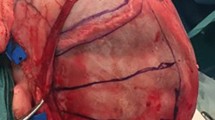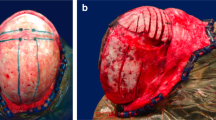Abstract
Purpose
The purpose of this study was to quantify the changes in frontal morphology in patients with scaphocephaly treated with a modified Pi procedure.
Methods
Consecutive scaphocephalic patients (n = 13) who underwent surgery before 12 months of age that had more than 1 year of follow-up and standard preoperative, 3-month, and 1-year photographs were included. Anthropometric measurements were used to document the craniofacial index. Computerized photogrammetric analyses of five craniofacial angles (bossing angle, nasofrontal angle, angle of facial convexity, and angle of total facial convexity) were also performed.
Results
Comparisons of the preoperative and postoperative direct anthropometric measurements of the cephalic index showed a significant (all p < 0.05) increase in the postoperative period, with no significant differences in early versus late postoperative period comparisons. Comparisons of the preoperative and postoperative computerized photogrammetric measurements of the craniofacial angles showed a significant (all p < 0.05) reduction (bossing angle, angle of facial convexity, and angle of total facial convexity) and increase (nasofrontal angle) in the early and late postoperative periods.
Conclusions
Frontal morphology significantly changed over the first year of the modified Pi procedure.






Similar content being viewed by others
References
Lajeunie E, Le Merrer M, Bonaiti-Pellie C, Marchac D, Renier D (1996) Genetic study of scaphocephaly. Am J Med Genet 62(3):282–285
Antunez S, Arnaud E, Cruz A, Marchac D, Renier D (2009) Scaphocephaly. Part I: indices for scaphocephalic frontal and occipital morphology evaluation: long-term results. J Craniofac Surg 20(Suppl 2):1837–1842
Khechoyan D, Schook C, Birgfeld CB, Khosla RK, Saltzman B, Teng CC, Ettinger R, Gruss JS, Ellenbogen R, Hopper RA (2012) Changes in frontal morphology after single-stage open posterior-middle vault expansion for sagittal craniosynostosis. Plast Reconstr Surg 129(2):504–516
Kohan E, Wexler A, Cahan L, Kawamoto HK, Katchikian H, Bradley JP (2008) Sagittal synostotic twins: reverse pi procedure for scaphocephaly correction gives superior result compared to endoscopic repair followed by helmet therapy. J Craniofac Surg 19(6):1453–1458
Weinzweig J, Baker SB, Whitaker LA, Sutton LN, Bartlett SP (2002) Delayed cranial vault reconstruction for sagittal synostosis in older children: an algorithm for tailoring the reconstructive approach to the craniofacial deformity. Plast Reconstr Surg 110(2):397–408
McCarthy JG, Bradley JP, Stelnicki EJ, Stokes T, Weiner HL (2002) Hung span method of scaphocephaly reconstruction in patients with elevated intracranial pressure. Plast Reconstr Surg 109(6):2009–2018
Cartwright CC, Jimenez DF, Barone CM, Baker L (2003) Endoscopic strip craniectomy: a minimally invasive treatment for early correction of craniosynostosis. J Neurosci Nurs 35(3):130–138
Fearon JA, McLaughlin EB, Kolar JC (2006) Sagittal craniosynostosis: surgical outcomes and long-term growth. Plast Reconstr Surg 117(2):532–541
Denadai R, Raposo-Amaral CA, Buzzo CL, Raposo-Amaral CE (2015) Isolated autologous free fat grafting for management of facial contour asymmetry in a subset of growing patients with craniofacial microsomia. Ann Plast Surg. doi:10.1097/SAP.0000000000000533
Raposo-Amaral CE, Denadai R, Camargo DN, Artioli TO, Gelmini Y et al (2013) Parry-Romberg syndrome: severity of the deformity does not correlate with quality of life. Aesthet Plast Surg 37(4):792–801
Raposo-Amaral CE, Denadai R, Ghizoni E, Buzzo CL, Raposo-Amaral CA (2015) Facial changes after early treatment of unilateral coronal synostosis question the necessity of primary nasal osteotomy. J Craniofac Surg 26(1):141–146
Raposo-Amaral CE, Giancolli AP, Denadai R, Somensi RS, Raposo-Amaral CA (2014) Late cutaneous lip height in unilateral incomplete cleft lip patients does not differ from the normative data. J Craniofac Surg 25(1):308–313
Han K, Kwon HJ, Choi TH, Kim JH, Son D (2010) Comparison of anthropometry with photogrammetry based on a standardized clinical photographic technique using a cephalostat and chair. J Craniomaxillofac Surg 38(2):96–107
Dalci K, Cetine S (2011) Soft tissue profiles of 3–5 year old preschool children. J Clin Pediatr Dent 35(3):339–344
Fernandez-Riveiro P, Smyth-Chamosa E, Suarez-Quintanilla D, Suarez-Cunqueiro M (2003) Angular photogrammetric analysis of the soft tissue facial profile. Eur J Orthod 25(4):393–399
Guyuron B (1988) Precision rhinoplasty. Part I: the role of life-size photographs and soft-tissue cephalometric analysis. Plast Reconstr Surg 81(4):489–499
Heuze Y, Boyadjiev SA, Marsh JL, Kane AA, Cherkez E, Boggan JE, Richtsmeier JT (2010) New insights into the relationship between suture closure and craniofacial dysmorphology in sagittal nonsyndromic craniosynostosis. J Anat 217(2):85–96
Hashim PW, Patel A, Yang JF, Travieso R, Terner J, Losee JE, Pollack I, Jane J Sr, Jane J Jr, Kanev P, Mayes L, Duncan C, Bridgett DJ, Persing JA (2014) The effects of whole-vault cranioplasty versus strip craniectomy on long-term neuropsychological outcomes in sagittal craniosynostosis. Plast Reconstr Surg 134(3):491–501
Maugans TA, McComb JG, Levy ML (1997) Surgical management of sagittal synostosis: a comparative analysis of strip craniectomy and calvarial vault remodeling. Pediatr Neurosurg 27(3):137–148
Greensmith AL, Holmes AD, Lo P, Maxiner W, Heggie AA, Meara JG (2008) Complete correction of severe scaphocephaly: the Melbourne method of total vault remodeling. Plast Reconstr Surg 121(4):1300–1310
Jimenez DF, Barone CM (2000) Endoscopy-assisted wide-vertex craniectomy, “barrel-stave” osteotomies, and postoperative helmet molding therapy in the early management of sagittal suture craniosynostosis. Neurosurg Focus 9(3):e2
Xenos C, Sgouros S, Natarajan K (2002) Ventricular volume change in childhood. J Neurosurg 97(3):584–590
Zhang L, Thomas KM, Davidson MC, Casey BJ, Heier LA et al (2005) MR quantitation of volume and diffusion changes in the developing brain. AJNR Am J Neuroradiol 26(1):45–49
Sauerhammer TM, Seruya M, Ropper AE, Oh AK, Proctor MR, Rogers GF (2014) Craniectomy gap patency and neosuture formation following endoscopic suturectomy for unilateral coronal craniosynostosis. Plast Reconstr Surg 134(1):81e–91e
Friede H, Lauritzen C, Figueroa AA (1996) Roentgencephalometric follow-up after early osteotomies in patients with scaphocephaly. J Craniofac Surg 7(2):96–101
Marsh JL, Jenny A, Galic M, Picker S, Vannier MW (1991) Surgical management of sagittal synostosis. A quantitative evaluation of two techniques. Neurosurg Clin N Am 2(3):629–640
Thomas GP, Johnson D, Byren JC, Jayamohan J, Magdum SA, Richards PG, Wall SA (2015) Long-term morphological outcomes in nonsyndromic sagittal craniosynostosis: a comparison of 2 techniques. J Craniofac Surg 26(1):19–25
Bonfield CM, Lee PS, Adamo MA, Pollack IF (2014) Surgical treatment of sagittal synostosis by extended strip craniectomy: cranial index, nasofrontal angle, reoperation rate, and a review of the literature. J Craniomaxillofac Surg 42(7):1095–1101
David LR, Plikaitis CM, Couture D, Glazier SS, Argenta LC (2010) Outcome analysis of our first 75 spring-assisted surgeries for scaphocephaly. J Craniofac Surg 21(1):3–9
Marcus JR, Stokes TH, Mukundan S, Forrest CR (2006) Quantitative and qualitative assessment of morphology in sagittal synostosis: mid-sagittal vector analysis. J Craniofac Surg 17(4):680–686
Fearon JA, Ruotolo RA, Kolar JC (2009) Single sutural craniosynostoses: surgical outcomes and long-term growth. Plast Reconstr Surg 123(2):635–642
Douglas TS (2004) Image processing for craniofacial landmark identification and measurement: a review of photogrammetry and cephalometry. Comput Med Imaging Graph 28(7):401–409
Naif-de-Andrade NT, Hochman B, Naif-de-Andrade CZ, Ferreira LM (2012) Computerized photogrammetry used to calculate the brow position index. Aesthet Plast Surg 36(5):1047–1051
Funding
None
Conflict of interest
The authors have no personal financial or institutional interest in any of the drugs, materials, or devices described in this article
Author information
Authors and Affiliations
Corresponding author
Rights and permissions
About this article
Cite this article
Raposo-Amaral, C.E., Denadai, R., Takata, J.P.I. et al. Progressive frontal morphology changes during the first year of a modified Pi procedure for scaphocephaly. Childs Nerv Syst 32, 337–344 (2016). https://doi.org/10.1007/s00381-015-2914-0
Received:
Accepted:
Published:
Issue Date:
DOI: https://doi.org/10.1007/s00381-015-2914-0




